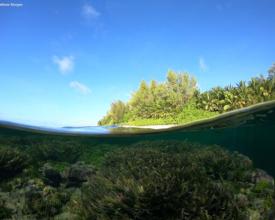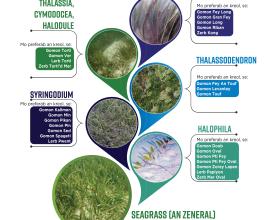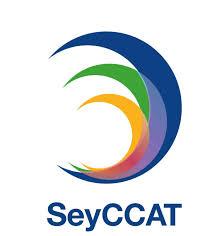
Intégrer les herbiers marins dans la langue créole seychelloise
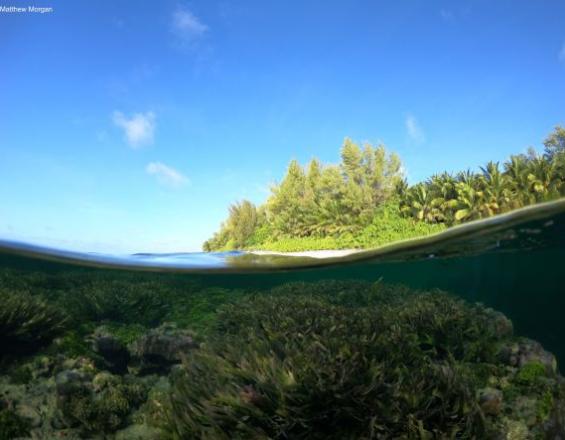
Le projet Coastal Wetlands & Climate Change, entrepris par le Seychelles Conservation and Climate Adaptation Fund, vise à fournir davantage de données scientifiques sur les herbiers marins des Seychelles et à sensibiliser la population à leurs avantages.
Le principal obstacle pour inciter la population à se préoccuper de la protection des herbiers marins était l'absence de nom créole pour ces derniers. Plusieurs termes non officiels étaient utilisés par les pêcheurs et les défenseurs de l'environnement pour désigner l'herbier et ses formes de vie, mais aucun d'entre eux n'était officiel.
Le projet a lancé une campagne nationale pour inciter la nation à participer à l'attribution d'un nom à l'herbier marin et à ses cinq formes de vie. La campagne s'est déroulée sur les plateformes de médias sociaux, à la radio et dans les journaux.
L'approche de proximité avec les pêcheurs locaux a été plus difficile à mettre en œuvre en raison des restrictions de mouvement imposées par le Covid-19. Les administrateurs de district ont été mobilisés pour faire circuler les formulaires physiques et aider les pêcheurs à les remplir.
L'exercice s'est avéré être un moyen "amusant" d'obtenir des informations et de sensibiliser les gens à la question des herbes marines.
Contexte
Défis à relever
D'une manière générale, il y a eu un mépris total pour les herbiers marins. Elle a été piétinée, déracinée par les bateaux à moteur et affectée de bien d'autres façons par d'autres facteurs/comportements humains.
Le fait d'avoir des noms et des termes seychellois-créoles pour désigner l'herbier marin l'intègre dans la culture des habitants. Cela permet à la communauté de se l'approprier et d'être plus consciente et désireuse de la protéger.
Emplacement
Traiter
Résumé du processus
Le fait d'inciter le public à participer à l'attribution d'un nom à une plante a créé un sentiment d'appartenance qui était essentiel au processus, mais aussi à la conservation à long terme de l'herbier marin aux Seychelles.
La collaboration avec l'Académie créole a validé l'exercice et lui a donné une importance nationale.
Blocs de construction
L'enquête publique
Une enquête nationale a été menée pour atteindre différents groupes du grand public. L'enquête avait deux fonctions : 1. recueillir des informations et 2. inciter les gens à comprendre l'objet de l'exercice et les sensibiliser à la question de l'herbier marin. L'enquête était accessible en ligne via le site web, mais elle a été promue à la radio, dans la presse écrite et dans les médias sociaux.
Facteurs favorables
La sensibilisation à l'enquête était importante, tout comme l'ajout d'images dans le document d'enquête pour le rendre convivial et amusant.
Leçon apprise
Des exemplaires imprimés de l'enquête ont été utilisés pour accéder à la communauté des pêcheurs. Les administrateurs de district ont été engagés pour faciliter le processus, car ils connaissaient les membres de leur district plus intimement.
Sans les restrictions imposées par Covid-19, le projet aurait sollicité l'aide d'étudiants universitaires pour atteindre un plus grand nombre de membres de la communauté des pêcheurs.
Ressources
L'Académie de la langue créole
L'Académie de la langue créole est l'organisme habilité à approuver de nouveaux mots dans la langue créole. Officiellement, la collaboration avec l'Académie était essentielle pour légitimer l'exercice et obtenir de nouveaux mots et termes officiels pour l'herbe de mer. D'autre part, la contribution de l'Académie a été essentielle pour garantir le maintien de l'élément culturel du processus de dénomination.
Facteurs favorables
La transparence a été un élément clé du processus afin de garantir que tout le monde soit tenu au courant de l'évolution de la situation. Un comité composé de linguistes, de défenseurs de l'environnement et de scientifiques a été créé pour filtrer les conclusions du public avant de les soumettre à l'Académie.
Leçon apprise
Pour introduire un nouveau mot dans une langue, il faut d'abord suivre un processus officiel. Il est important d'identifier toutes les étapes et tous les acteurs qui jouent un rôle dans cet exercice. Le Comité qui a été mis en place a été important pour ajouter de la légitimité et du soutien au processus - tous les acteurs clés devaient se sentir impliqués et c'était un bon moyen de les amener à collaborer et à échanger des idées. Cela a également facilité le travail de l'Académie, car les mots et les termes qui ont été soumis avaient été bien pensés.
Impacts
Institutionnaliser l'herbier dans la langue seychelloise-créole, c'est l'ancrer dans la culture et faire en sorte que la prochaine génération soit plus familière avec l'herbier, dans le contexte local.
Il est impératif d'inciter la population à s'engager activement dans la protection de l'herbier.
Les résultats de la campagne se font sentir aujourd'hui, puisque des centaines de Seychellois font référence aux habitats d'herbes marines dans les questions de développement côtier.
On comprend mieux le rôle des herbiers dans la croissance économique, la pêche artisanale, le tourisme, l'atténuation du changement climatique (séquestration du carbone par les herbiers), la protection de nos côtes et bien d'autres choses encore.
Bénéficiaires
Les parties prenantes des communautés de la pêche et du tourisme bénéficient de la conservation des herbiers marins. La communauté dans son ensemble également, grâce à l'éducation qui a permis de mieux comprendre les zones humides côtières du pays.
Objectifs de développement durable
Histoire
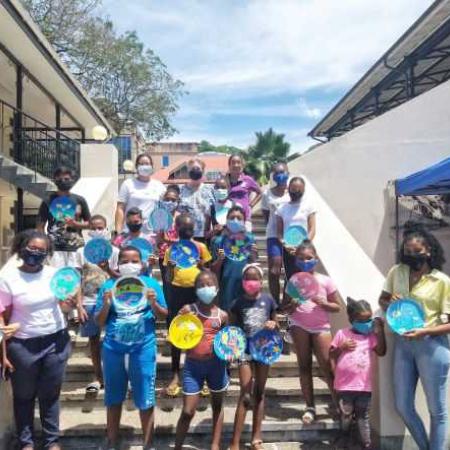
LES JEUNES : UN GROUPE CIBLE IMPORTANT
La dernière estimation de la population des Seychelles
était de 99 202 personnes (juin 2021, Bureau national des
Bureau national des statistiques), dont près de 22 % étaient âgés de 14 ans ou moins.
moins. La population jeune des Seychelles est un
groupe cible important pour les efforts de conservation
car ses membres sont les futurs gardiens des ressources naturelles de
des ressources naturelles de l'île.
Il était important pour le projet de présenter
l'herbe de mer d'une manière qui soit compréhensible et
et qui susciterait l'intérêt. Le terme "présenter" est pertinent, car on sait très peu de choses sur les herbiers marins.
est un mot pertinent, car on sait très peu de choses sur l'herbier
sur les îles en dehors de la communauté des pêcheurs
la communauté des pêcheurs et celle des biologistes marins et des défenseurs de l'environnement.
L'ampleur de ce "peu" est illustrée par le fait que
l'herbe de mer n'avait pas de nom seychellois-créole et était souvent
et qu'elle était souvent confondue avec les algues.
Méconnue - sans nom ; alors, par où commencer ?
commencer ?
La clé, comme l'a découvert le projet, était de l'associer à des éléments familiers aux jeunes.
à des éléments familiers aux jeunes
et susceptibles d'évoquer divers sentiments, tels que les
comme les tortues de mer, les poissons, les dugongs,
les oursins, les coraux et d'autres formes de vie marine qu'ils connaissaient personnellement ou qu'ils avaient eu l'occasion d'observer.
qu'ils connaissent personnellement ou qu'ils ont appris à aimer
des classiques de Disney comme "La petite sirène" ou "Finding Nemo".
ou "Finding Nemo".
Des cahiers d'activités adaptés à l'âge des enfants ont été
des livres d'activités adaptés à l'âge des enfants, remplis de points et de points,
mots croisés, de puzzles et de mots cachés - tous avec un
avec un thème sous-jacent : ils sont tous liés à l'herbe de mer.
l'herbe de mer. Ces livres ont été utilisés comme matériel
matériel pédagogique dans le cadre d'un programme de
dans le cadre d'un programme de sensibilisation
projet.
Malheureusement, en raison des restrictions imposées par la
la pandémie au cours des deux dernières années, seules deux éditions du roadshow ont eu lieu.
deux éditions de la tournée de présentation ont eu lieu. La première
La première a eu lieu avec un groupe de 13 écoliers
qui ont participé au club de vacances d'été du Musée naturel de 2020
Club de vacances d'été du Musée naturel 2020 et la seconde avec 27
membres du Wildlife Club de l'école d'Anse Royale.
de l'école d'Anse Royale.
Les deux sessions comprenaient des présentations sur les herbes marines,
trier des spécimens d'herbes marines précédemment
de spécimens d'herbes marines collectés sur les plages et
des pages des cahiers d'activités. Une sortie sur le terrain a été
une sortie sur le terrain figurait au calendrier des activités de la deuxième session.
session, les élèves ont eu l'occasion de faire de la plongée en apnée
les herbiers marins dans les eaux peu profondes de la plage de l'Anse Aux Pins.
Pins.
En plus d'apprendre à identifier les herbiers marins dans leur
dans leur habitat naturel, cette activité a également
l'occasion de rappeler l'importance de ne pas piétiner
de ne pas piétiner les herbiers marins ; une leçon qu'ils
famille et leurs amis lors de futures sorties à la plage.
lors de futures sorties à la plage.
